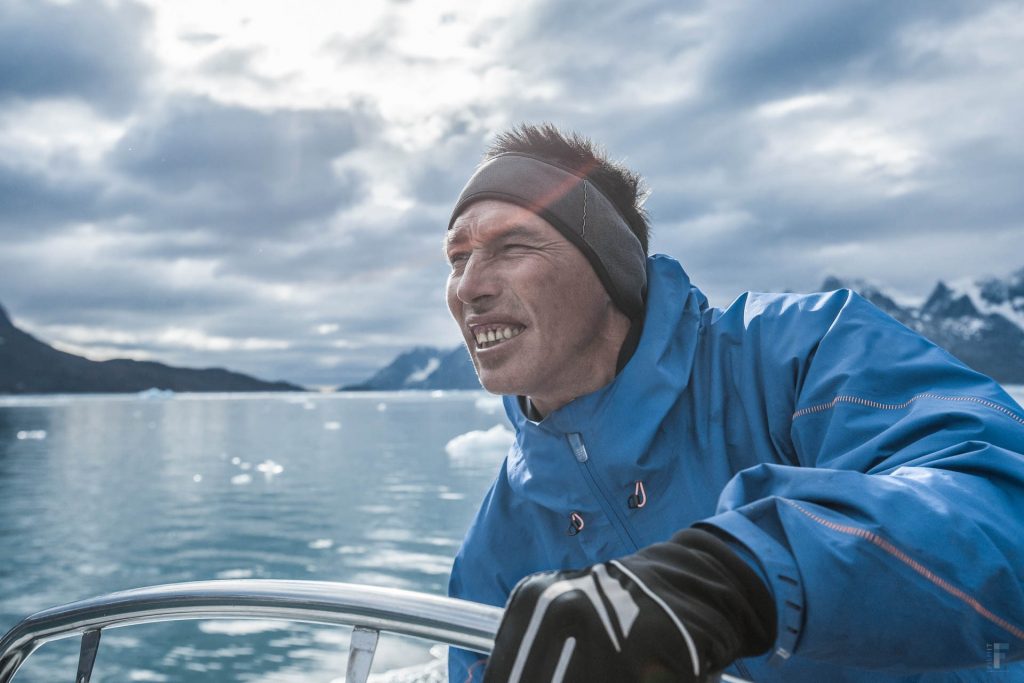(THIS ARTICLE IS MACHINE TRANSLATED by Google from Norwegian)
Every day, hundreds of species disappear from the earth. Complex, marginalized languages and civilizations are disappearing at an equally moving pace. Whole cultures are losing their living space. The dominant globalized and unidirectional culture hardly notices the disappearance: the collapse of contemporary cultures is not a topic for the big media.
Directors Jure Breceljnik and Rozle Bregar traveled far north, to East Greenland, to meet the last active Inuit hunters. The daily life of the Inuit has changed dramatically over the past decade, and the documentary sets out to show the weathering of this culture, amidst the overwhelmingly beautiful landscape. Using the cinematographic championship of Rozle Bregar and Wesley Johnson, and the camera work of Miha Augustin, the images act as a final protest cry from a seemingly intact nature – which asks for its right to survive.
Without a future
Behind the enchanting surface, the bitter and desperate living conditions of the "latest ice hunters" are hiding. Especially the younger generation is struggling in the global development race: they are driven out into alcoholism, or directly to suicide. The area tops the European suicide statistics.
The younger Inuit are driven into alcoholism or to suicide.
The young people have realized that the traditional lifestyle, which is centered around seal hunting, is no longer profitable and thus without a sustainable future. Foreign industrial hunting, with aggressive and sophisticated hunting technology, also destroys the breeding grounds of selenium and has caused irreparable damage. Traditional hunting methods seem anachronistic compared to this destructive violence. However, acquiring new hunting equipment costs more money than you can profit from using it.
On the other hand, young people are confronted with an unattainable western standard of living when they meet the tourists who come by. Compared to the West's comfort, the Inuit's harsh living conditions seem unacceptable to young people. Still, there are few achievable alternatives; Applying for jobs in larger neighboring cities provides, at best, poorly paid routine jobs, which are also only temporary.
Cultural figure
In Inuit culture, the hunter had a central place with great status; he was a craftsman, specialist and artist. When this status is lost, the culture can only collapse. Traditional society was based on self-hunting without commercial goals, but as a sustainable way of life. Over-taxation was unknown. Protecting the basis of life, especially the growth areas of the harness, was a priority. All parts of the prey were used or eaten.

Greenpeace, who was previously very critical of seal hunting along with celebrities such as Brigitte Bardot, later admitted that they misjudged the actual conditions of this type of hunting, and have formally apologized; Inuit culture has been "sustainable" in an exemplary way.
“Eating what we hunt is the very essence of being Inuit. When we can no longer hunt for drift ice and eat what we hunt, we will no longer exist as a people, ”says militant Inuit ecologist Sheila Watt-Cloutier at the beginning of the documentary. Inuit culture is centered around hunting and preparing food. In one scene, we see a housewife sitting on the floor in her well-equipped, modern kitchen and preparing dishes. She presents a dozen body parts of animals and fish to the filmmakers.
Inuit culture is based on a cyclical conservation of resources.
The portraits of some select families and individuals are central to it The Last Ice Hunters. What these have in common is the attempt to continue traditional life. There are believed to be 50 active hunters per 3000 population, and some youths follow their fathers out on their expeditions; With them, traditional culture and ditto techniques are still alive. But not many meters away, the large containers are unloaded in the harbor, which is now ice-free several months a year.
Export
One possible way to maintain a vibrant society under changing conditions would be to establish its own export industry. Containers can now bring the fruits of hunting and fishing out into the world. Of course, this would mean renouncing the resistance to over-taxation. But without increased revenue, a modern life, with the import of new technology, food and motorization, cannot continue. Most of the inhabitants have already been forced to emigrate. Others have chosen hunting tourism as a survival model, combined with temporary jobs from home. Limiting oneself solely to hunting would mean the risk of starving during periods of bad weather. Yet many return home, at least for part of the year – "not to get rich, but to grow as a human," as one of them puts it.

Breceljnik and Bregar point out that microcultures that have worked for hundreds of years lose their survival potential when faced with massive technological and climatic changes. The loss of culture degrades their existence and makes them anonymous, servile, and interchangeable family caregivers in an uncontrolled and directionless global consumer culture. The survival of their families is the only remaining center in existence.
Inuit culture lacks words and concepts about "future". In a culture that continually recreates itself, and does not set the individual at the highest, it is not so surprising. It is a culture of cyclical conservation of resources, characterized by well-established actions and practices. This model of life is a clear alternative to today's consumer culture, which drives global destruction of all life – both human life and other life. But tragically, this type of culture is defenseless when its foundation is trampled upon. Strategic approaches from the larger community are needed to transform cultures into a permanent crisis. Here, original members of such cultures become only marginal spectators.
See also: Has man ever really lived with nature in freedom and equality, and then ended up in the links of modernity?
Read the essay Problems with social inequality


